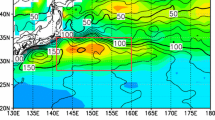Abstract
Large-scale aspects of the North Pacific subtropical gyre have been investigated using a climatology of temperature and salinity (World Ocean Atlas 1998). In the central and eastern parts of the basin, the axis of the subtropical gyre, defined as the meridional maximum of dynamic height, tends to move poleward from about 25°N near the surface to about 40°N in the upper intermediate layers. In the western part of the basin, the axis is seen at about 30°N, remaining almost unchanged with depth. Striking features associated with this vertical distribution include a northward shift of the bifurcation latitude of the North Equatorial Current at increasing depth and a barotropic nature of the confluence point between the Kuroshio and Oyashio at their respective western boundaries. The former occurs at about 14°N near the surface and extends north of 20°N at depths around 800 m. The latter, situated at about 36.4°N off Japan, does not appear to have a strong signature of depth-dependence. While some of these results are already known from sporadic hydrographic observations, they have not hitherto been represented in a three-dimensional climatology.
Similar content being viewed by others
References
Hellerman, S. and M. Rosenstein (1983): Normal monthly wind stress over the world ocean with error estimates. J. Phys. Oceanogr., 13, 1093–1104.
Huang, R. X. (1988): On boundary value problems of the ideal-fluid thermocline. J. Phys. Oceanogr., 18, 619–641.
Hurlburt, H. E., A. J. Wallcraft, W. J. Schmitz, P. J. Hogan and E. J. Metzger (1996): Dynamics of the Kuroshio/Oyashio current system using eddy-resolving models of the North Pacific Ocean. J. Geophys. Res., 101, 941–976.
Kawai, H. (1972): Hydrography of the Kuroshio Extension. p. 235–354. In Kuroshio: Physical Aspects of the Japan Current, ed. by H. Stommel and K. Yoshida, University of Washington Press.
Lukas, R., E. Firing, P. Hacker, P. L. Richardson, C. A. Collins, R. Fine and R. Gammon (1991): Observations of the Mindanao Current during the Western Equatorial Pacific Ocean Circulation Study. J. Geophys. Res., 96, 7089–7104.
Luyten, J. R., J. Pedlosky and H. Stommel (1983): The ventilation thermocline. J. Phys. Oceanogr., 13, 292–309.
Masumoto, Y. and T. Yamagata (1991): Response of the western tropical pacific to the Asian winter monsoon: The generation of the Mindanao Dome. J. Phys. Oceanogr., 21, 1386–1398.
McCreary, J. P. and P. Lu (1994): Interaction between the subtropical and equatorial ocean circulations: The Subtropical Cell. J. Phys. Oceanogr., 24, 466–497.
Mizuno, K. and W. B. White (1983): Annual and interannual variability in the Kuroshio current system. J. Phys. Oceanogr., 13, 1847–1867.
Qiu, B. (1995): Variability and energetics of the Kuroshio Extension and its recirculation gyre from the first two-year TOPEX data. J. Phys. Oceanogr., 25, 1827–1842.
Qiu, B. and R. Lukas (1996): Seasonal and interannual variability of the North Equatorial Current, the Mindanao Current and the Kuroshio along the Pacific western boundary. J. Geophys. Res., 101, 12315–12330.
Qu, T., T. Kagimoto and T. Yamagata (1997): A subsurface countercurrent along the east coast of Luzon. Deep-Sea Res. I, 44, 413–423.
Qu, T., H. Mitsudera and T. Yamagata (1999): A climatology of the circulation and water mass distribution near the Philippine coast. J. Phys. Oceanogr., 29, 1488–1505.
Qu, T., H. Mitsudera and B. Qiu (2001): A climatological view of the Kuroshio/Oyashio system east of Japan. J. Phys. Oceanogr., 31, 2575–2589.
Reid, J. L. (1961): On the geostrophic flow at the surface of the Pacific Ocean with respect to the 1000–decibar surface. Tellus, 13, 489–502.
Reid, J. L. and R. S. Arthur (1975): Interpretation of maps of geopotential anomaly for deep Pacific Ocean. J. Mar. Res., 33(Suppl.), 37–52.
Reid, J. L. and A. W. Mantyla (1978): On the mid-depth circulation of the North Pacific Ocean. J. Phys. Oceanogr., 8, 946–951.
Rhines, P. B. and W. R. Young (1982): A theory of the wind-driven circulation, I: Mid-ocean gyre. J. Mar. Res., 40(Suppl.), 559–596.
Roden, G. I., B. A. Taft and C. C. Ebbesmeyer (1982): Oceanographic aspects of the Emperor Seamounts region. J. Geophys. Res., 87, 9537–9552.
Toole, J., C. Millard, Z. Wang and S. Pu (1990): Observations of the Pacific North Equatorial Current bifurcation at the Philippine coast. J. Phys. Oceanogr., 20, 307–318.
Author information
Authors and Affiliations
Corresponding author
Rights and permissions
About this article
Cite this article
Qu, T. Depth Distribution of the Subtropical Gyre in the North Pacific. Journal of Oceanography 58, 525–529 (2002). https://doi.org/10.1023/A:1021221500837
Published:
Issue Date:
DOI: https://doi.org/10.1023/A:1021221500837




